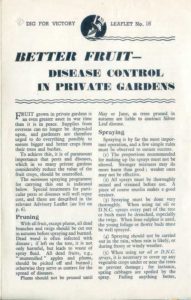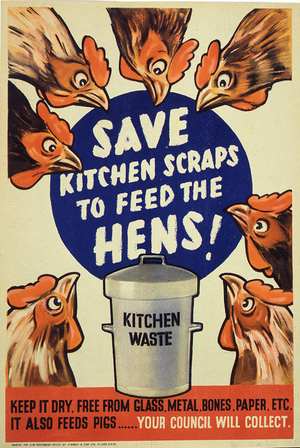BETTER FRUIT-
DISEASE CONTROL IN PRIVATE GARDENS
 Fruit grown in private gardens is an even greater asset in war time than it is in peace. Supplies from overseas can no longer be depended upon, and gardeners are therefore urged to do everything possible to ensure bigger and better crops from their trees and bushes.
Fruit grown in private gardens is an even greater asset in war time than it is in peace. Supplies from overseas can no longer be depended upon, and gardeners are therefore urged to do everything possible to ensure bigger and better crops from their trees and bushes.
To achieve this, it is of paramount importance that pests and diseases, which in so many private gardens considerably reduce the value of the fruit crops, should be controlled.
The minimum spraying programme for carrying this out is indicated below. Special treatments for particular pests or diseases will well repay cost, and these are described in the relevant Advisory Leaflet (see list on p. 6).
Pruning
With all fruit, except plums, all dead branches and twigs should be cut out in autumn before spraying and burned. Dead wood is often infected with disease; if left on the tree, it is not only harmful, but leads to waste of spray fluid. All dead fruits, e.g., ” mummified” apples and plums, should be picked off and burned; otherwise they serve as centres for the spread of diseases.
Plums should not be pruned until May or June, as trees pruned in autumn are liable to contract Silver Leaf disease.
Spraying
Spraying is by far the most important operation, and a few simple rules must be observed to ensure success.
(1) The proportions recommended for making up the sprays must not be altered. Stronger mixtures may do more harm than good; weaker ones may not be effective.
(2) All sprays must be thoroughly mixed and strained before use. A piece of coarse muslin makes a good strainer
(3) Spraying must be done very thoroughly. When using tar oil or D.N.C. sprays every part of the tree or bush must be drenched, especially the twigs. When lime sulphur is used, the young foliage or flower buds must be well sprayed.
(4) Spraying should not be carried out in the rain, when rain is likely, or during frosty or windy weather.
(5) When using tar oil or D.N.C. sprays, it is necessary to cover up any vegetable crops under or near the trees to prevent damage; for instance, spring cabbages are spoiled by the spray.
Failing anything better, covering with newspaper affords reasonable protection.
(6) Lime-sulphur spray does little harm to most vegetable crops except lettuce, which should be adequately protected
(7) Flowering plants and hedges may be damaged; if accidentally sprayed, they should be thoroughly washed with the garden hose before the spray has time to dry.
(8) The quantity of spray to be used varies according to the size of the tree or bush. For fruit trees the following table shows the average quantities required:
| Diameter of Spread of Tree |
No. of Gallons of Dilute Wash per Tree |
|---|---|
| 10-12 ft. | 1 gal. |
| 12-15 ft. | 11/2 gal. |
| 15-18 ft. | 21/4 gal. |
| 18-21 ft. | 3 gal. |
| 21-24 ft. | 4 gal. |
For blackcurrants, gooseberries and other bush fruit, 1 gal. of spray will suffice for 1-10 bushes, according to size.
(9) Spraying equipment must be washed after use.
(10) No more spray than is required for a day’s work should be made up at a time


